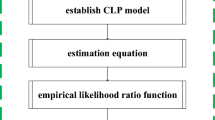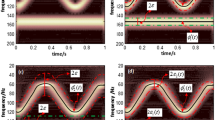Abstract
In order to realize the signal detection under the condition of lower SNR, this paper introduced the adaptive phase length based on the Duffing chaotic system and verified the measured signal at the optimal excitation frequency. The existence of the target signal was judged by observing whether there are two consecutive intermittent chaos in the time domain. Then the envelope of the intermittent chaos was obtained by Hilbert transform. Finally, the exact value of envelope spectrum was obtained by using the one-and-half-dimension spectrum, which can calculate the precise value of the frequency of the signal to be measured. The experimental results showed that the proposed algorithm can achieve a lower SNR than the conventional detection. Compared with the general chaotic detection, this algorithm can realize smart self-adaptation. It is unnecessary to specify different excitation frequencies and chaotic thresholds for different frequencies to be measured. In addition to the existence of the target signal judgment, the algorithm can also achieve accurate calculation of the frequency of the signal to be measured.






Similar content being viewed by others
Explore related subjects
Discover the latest articles, news and stories from top researchers in related subjects.References
Yao HY, Wang HY, Zhang ZC, Shen XH (2017) A method of detecting underwater weak target based on generalized Duffing oscillator. Acta Phys Sin 66(12):227–238
Li GZ, Zhang B (2017) Novel method for detecting weak signal with unknown frequency based on Duffing oscillator. Chin J Sci Instrum 38(01):181–189
Lai ZH, Rao XX, Liu JS, Leng YG (2016) Signal spectrum reconstruction stochastic resonance method based on a Duffing oscillator. J Vib Shock 35(21):9–16
Wang HW, Cong C (2016) A new signal detection and estimation method by using Duffing system. Acta Electron Sin 44(06):1450–1457
Lai ZH, Leng YG (2016) Weak-signal detection based on the stochastic resonance of bistable Duffing oscillator and its application in incipient fault diagnosis. Mech Syst Signal Process 81:60–74
Dang J, Jia R, Luo XQ, Wu H, Chen DY (2016) Partly Duffing oscillator stochastic resonance method and its application on mechanical fault diagnosis. Shock Vib 3:1–14
Chen ZG, Li YA, Chen X (2015) Underwater acoustic weak signal detection based on Hilbert transform and intermittent chaos. Acta Phys Sin 64(20):73–80
Cong C, Xiukun L, Yang S (2016) A ship line spectrum detection method based on intermittent chaotic oscillator model. Acta Phys Sin 63(6):064301–064311
Fan J, Zhao WL, Wang WQ (2013) Study on the weak sinusoidal signal detection property using Duffing chaos system. Acta Phys Sin 62(18):54–59
Lu M, Ma SS, Ding JF, Huang W, Yuan H (2017) Weak signal detection system based on Duffing oscillator with linear driven by to-be-detected signal. J Central South Univ Sci Technol 48(03):721–728
Guo Q, Nan PL (2014) Method for feature extraction of radar full pulses based on EMD and chaos detection. J Commun Netw 16(1):92–97
Abanda Y, Tiedeu A (2016) Image encryption by chaos mixing. IET Image Process 10(10):742–750
Liu HB, Wu DW, Lu H, Wang YQ, Jiang WT (2013) A new frequency measuring method by using Duffing oscillator’s. Phase trajectory in great periodic motion. Acta Electron Sin 41(10):2010–2015
Niu DZ, Chen CX (2015) Blind angle elimination method in weak signal detection with Duffing oscillator and construction of detection static. Acta Phys Sin 64(6):503–511
Liu HB, Wu DW, Dai CJ, Mao H (2013) A new weak sinusoidal signal detection method based on Duffing oscillators. Acta Electron Sin 41(01):8–12
Li L, Liu CG, Shi S, Zhang XD (2012) A method of weak signal detection based on chaotic oscillator and Lyapunov exponent. J Nat Sci Heilongjiang Univ 29(04):556–560
Medak B, Tret’yakov AA (2017) Application of p-regularity theory to the Duffiing equation. Bound Value Probl 1:1–9
Han JQ (2013) A method of narrowing frequency range of intermittent sine signal detected by Duffing system. Acta Electron Sin 41(4):733–738
Deng DH, Zhang Q (2014) The application of Duffing oscillators to micro-motion feature extraction of radar target under low SNR. J Electron Inf Technol 36(2):453–458
Lai ZH, Leng YG, Sun JQ, Fan SB (2012) Weak characteristic signal detection based on scale transformation of Duffing oscillator. Acta Phys Sin 61(05):60–68
Wang GY, Chen DJ, Lin JY, Chen X (1999) The application of chaotic oscillators to weak signal detection. IEEE Trans Ind Electron 46(2):440–444
Acknowledgements
The authors acknowledge the National Natural Science Foundation of China (Grant: 11574120, U1636117), the Natural Science Foundation of Jiangsu province of china (Grant: BK20161359); The Science and Technology on Underwater Acoustic Antagonizing Laboratory, Systems Engineering Research Institute of CSSC(Grant No. MB80038); The research presented in this paper was supported by the Open Project Program of the Key Laboratory of Underwater Acoustic Signal Processing, Ministry of Education, China (UASP1503) and Six Talent Peaks project of Jiangsu Province.
Author information
Authors and Affiliations
Corresponding author
Rights and permissions
About this article
Cite this article
Biao, W., Yu, F., Yang, W. et al. An adaptive data detection algorithm based on intermittent chaos with strong noise background. Neural Comput & Applic 32, 16755–16762 (2020). https://doi.org/10.1007/s00521-018-3839-9
Received:
Accepted:
Published:
Issue Date:
DOI: https://doi.org/10.1007/s00521-018-3839-9




